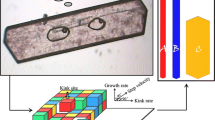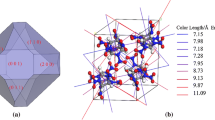Abstract
The effect of crystal modifier 2,2’,4,4’,6,6’-hexanitrostillbene(HNS) on the reinforcement of crystalline 1,3,5-trinitrotoluene (TNT) was investigated by molecular simulation. The intermolecular interactions between HNS and TNT were revealed by quantum chemistry calculations in detail, strong attractive forces were found between HNS and TNT. The solid interface models of TNT/HNS along three crystalline directions were studied, the distance between HNS molecule and TNT system was narrowed after optimization; the mechanical properties were calculated, showing the mechanism of the reinforcement.





Similar content being viewed by others
References
Shu YJ, Huo JC (2011) Introduction to explosives. Chemical Industry Press, Beijing
Smith DL, Thorpe BW (1973) J Mater Sci 8:757–759
Ma Q, Shu YJ, Luo G, Chen L, Zheng BH, Li HR (2012) Toughening and elasticizing route of TNT based melt cast explosives. Chin J Energ Mater 20(5):618–629
Portnoy S, Livingston NJ (1982) Production of fine-grained cast charges with unoriented crystal structure of TNT or explosive compositions containing TNT. US4360394
Trevino SF, Portnoy S, Choi CS (1979) Effects of HNS on Cast TNT. ARLCD-MR-79001
Parry MA, Thorpe BW (1978) Nucleation and growth of TNT containing HNS. MRL-R-708
Parry MA, Thorpe BW (1979) The effective nucleant during the grain modification of TNT with HNS. MRL-R-748
Cartwright M, Hill CJ (1995) Thermal investigation of the crystallization nucleant formed between HNS and TNT. J Therm Anal 44:1021–1036
Qian W, Shu YJ (2013) Progress of computer simulation for intermolecular interactions in composite explosive. Chin J Energ Mater 21(5):629–637
Li JS, Xiao HM, Dong HS (2000) A study on the intermolecular interaction of energetic system-mixtures containing -CNO2 and -NH2 groups. Prop Explos Pyrotech 25(1):26–30
Niu XQ, Zhang JG, Feng XJ, Chen PW, Zhang TL, Wang SY, Zhang SW, Zhou ZN, Yang L (2011) Theoretical investigation on intermolecular interactions between the ingredients TNT and RDX of composition B. Acta Chim Sinica 69(14):1627–1638
Chen L, Li HR, Xiong Y, Xu RJ, Xu T, Liu XF, Shu YJ (2012) Structure and molecular interaction of methyl-nitroguanidine and hydrazine nitrate eutectics. Chin J Energ Mater 20(5):560–564
Li HR, Shu YJ, Chen L, Ma Q, Ju XH (2013) Theoretical insights into the nature of intermolecular interactions in TNT/CL-20 cocrystal and its properties. Proceedings of the 16th Seminar on New Trends in Research of Energetic Materials, Pardubice, Czech Republic, 742–753
Li HR, Shu YJ, Gao SJ (2013) Easy methods to study the smart energetic TNT/CL-20 co-crystal. J Mol Model 19(11):4909–4917
Accelrys Software Inc (2012) Materials Studio Release Notes, Release 6.1. Accelrys Software Inc, San Diego
Carper WR, Davis LP, Extine MW (1982) Molecular structure of 2,4,6-trinitrotoluene. J Phys Chem 86:459
Delley B (1990) J Chem Phys 92:508
Delley B (2000) J Chem Phys 113:7756
Perdew JP, Burke K, Ernzerhof M (1996) Generalized gradient approximation made simple. Phys Rev Lett 77:3865–3868
Qiu L, Xiao H (2009) Molecular dynamics study of binding energies, mechanical properties, and detonation performances of bicyclo-HMX-based PBXs. J Hazard Mater 164:329–336
Murray JS, Politzer P (2011) The electrostatic potential: an overview. WIREs Comp Mol Sci 1:153–163
Sun H (1998) COMPASS: an ab initio forcefield optimized for condensed-phase applications — overview with details on alkane and benzene compounds. J Phys Chem B 102:7338
Sun H, Ren P, Fried JR (1998) The COMPASS forcefield: parameterization and validation for polyphosphazenes. Comput Theor Polym Sci 8:229
Rigby D, Sun H, Eichinger BE (1998) Computer simulations of poly (ethylene oxides): forcefield, PVT diagram and cyclization behavior. Polym Int 44:311–330
Andersen HC (1980) Molecular dynamics simulations at constant pressure and/or temperature. J Phys Chem 72:2384
Berendsen HJC, Postma JPM, van Gunsteren WF, DiNola A, Haak JR (1984) Molecular dynamics with coupling to an external bath. J Chem Phys 81:3684–3690
Verlet L (1967) Computer experiments on classical fluids. I. Thermodynamical properties of Lennard-Jones molecules. Phys Rev 159:98–103
Ewald PP (1921) Die Berechnung optischer und elektrostatischer Gitter potentiale (The calculation of optical and electrostatic lattice potentials). Ann Phys Leipzig 64:253
Karasawa N, Goddard WA (1989) Acceleration of convergence for lattice sums. J Phys Chem 93:7320–7327
Watt JP, Davies GF, O’Connell RJ (1976) The elastic properties of composite materials. Rev Geophys Space Phys 14:541–563
Weiner JH (1983) Statistical mechanics of elasticity. Wiley, New York
Beijer FH, Kooijman H, Spek AL, Sijbesma RP, Meijer EW (1998) Self-complementarity achieved through quadruple hydrogen bonding. Angew Chem Int Ed 37(1–2):75–78
Hunter CA, Sanders JKM (1990) The nature of π-π interactions. J Am Chem Soc 112(14):5525–5534
Acknowledgments
The authors acknowledge the support of NSAF Fund (Grant No.11076002) and NSFC Fund (Grant No.51373159). The computation resources in the Simulation Center of CAEP are appreciated.
Author information
Authors and Affiliations
Corresponding author
Rights and permissions
About this article
Cite this article
Qian, W., Shu, Y., Li, H. et al. The effect of HNS on the reinforcement of TNT crystal: a molecular simulation study. J Mol Model 20, 2461 (2014). https://doi.org/10.1007/s00894-014-2461-8
Received:
Accepted:
Published:
DOI: https://doi.org/10.1007/s00894-014-2461-8




